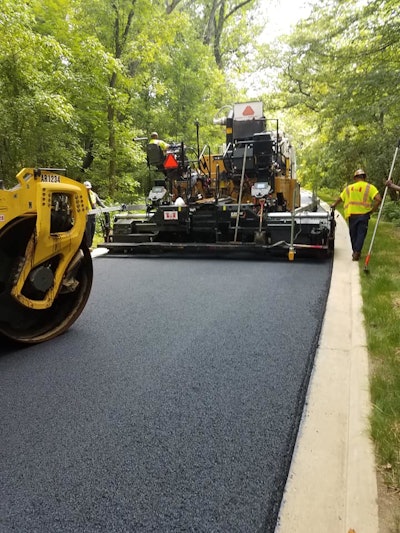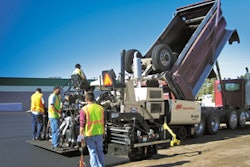
Most people who work on a road crew know that there's a lot more to building a long-lasting, quality roadway than just putting some hot rocks on the ground and compacting them. Time and energy in project planning, mix design and machine maintenance are all spent in order to achieve the desirable end result: a smooth pavement that will stand up to the test of time and the view of the traveling public. In order to achieve that end result, start with these tips:
1. Make a Plan
Before even starting a job, effective companies will start planning long before actual construction begins, and continue revising and developing plans until the project ends. The design, pre-construction, and procurement stages of a construction project each require extensive planning — and each may need to be revised as the next stage unfolds.
2. Communicate
Anything can happen at a construction site which is why communication is essential to every phase of any construction project. Establish a flow of communication with everyone on the ground — and every stakeholder and supplier in the plan. This transparency will make the process smoother and will reduce the number of emails and phone calls whenever a problem arises.
3. Proper Equipment Set Up
Making sure your equipment is ready before it even gets to the jobsite is an essential first step in laying a quality mat. Completing equipment walk arounds and verifying proper maintenance programs have been completed is a good first step in ensuring the equipment will be running for the total amount of time it’s needed on the job.
Check that the equipment has been properly cleaned, all fluid levels are set, screed plates, spray nozzles, tank levels, etc. are all good to go on your machines. Any component you’re not confident will to last for the duration of the work should be replaced before you leave the shop.
Read Next: Comprehensive Guide to Asphalt Paver Maintenance
4. Right Tools for the Job
Before you leave the shop, make sure you’re takin the best pieces of equipment with you to accomplish the jobsite plan. If you think there is a chance you may need additional equipment, contact your dealer and arrange it to be transported to your jobsite.
Also make sure you have the support equipment in place as well. If you’re milling, make sure you’ve coordinated with a sweeper as well as the trucks to transport the material. If you’re paving, do you have the right rollers in the fleet? Breakdown, pneumatic and finish rollers all have different roles that they play during compaction.
5. Maintain Consistency
When paving, consistency is key for a quality mat. Mix consistency, temperature consistency, a consistent paving speed, a consistent roller pattern and more all play a part in producing long-lasting roadways. If one of these doesn’t seem to be out of balance, refer back to number two and communicate through the proper channels that adjustments need to be made before it’s too late.
6. Paving Speed
In an ideal paving operation, the paver will operate nonstop throughout the day, because a change in paving speed can directly affect the ability to lay a uniform mat. Ripples, waves and irregular mat depth can occur when paving speed doesn’t remain relatively constant. When setting the paving speed, consider the number and size of trucks, volume and output of the mixing plant, rolling and compaction rates and crew capabilities, plus the distance from the mixing plant to the paver. These are all things that should be addressed during the planning phase of the job.
Read Next: Why Tracking Temperatures is Key to Successful Asphalt Paving
7. Head of Material
The “head of material” is the mass of paving mix that lies directly in front and spans the width of the screed. If this fluctuates widely during paving, it is nearly impossible to produce a level and smooth pavement surface. An increase in the head of material increases mat thickness and can translate into a wavy surface, and a decrease reduces the mat thickness and causes major flaws. The correct head of material should be constant across the entire width of the screed.
8. Mix Temperature
Creating density is easiest when you’re at the highest temperature for the type of roller you’re using. Typically, asphalt comes out of the plant at about 300° F. At that temperature, it is relatively soft and is readily compacted. As it cools, it firms up and compaction becomes increasingly difficult.
Whether it is conventional hot mix or warm mix or any other type asphalt mix, it needs to be rolled and compacted while it is hot.
9. Rolling Pattern
Maintaining a precise rolling pattern is the final, and especially crucial, step in the road building process. You want to make sure your crew is completing the most number of roller passes while the mix is still HOT. An efficient rolling pattern that covers as much of the paved area in as short amount of time as possible is generally the best approach to achieving density.
Read Next: How to Compact Asphalt Pavements
Rollers are the last piece of equipment to touch the mat after it is placed and are the last opportunity to “undo” the smooth mat that the paver has placed. Always have a “Plan B” if density is not being achieved and a means to communicate that to the rest of the crew.
10. Training
No matter how well you think you know how to achieve a quality mat, your plan and equipment are only going to be as good as the people who execute them which is why training plays a big role in helping operators know what factors affect a quality mat.
Precision and efficiency don’t come from equipment alone – people make the difference.




















